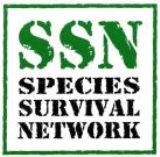
Species Survival Network
Encyclopedia
The Species Survival Network (SSN), founded in 1992, is an international coalition of over 80 non-governmental organizations (NGOs) committed to the promotion, enhancement, and strict enforcement of the Convention on International Trade in Endangered Species of Wild Fauna and Flora (CITES). Through scientific and legal research, education and advocacy, the SSN is working to prevent over-exploitation of animals and plants due to international trade.
The trade in parrots for pets, alligator
hide handbags, dried seahorse
curios, elephant
ivory
, and ramin
pool cues--just a few examples of the billion dollar international trade in wildlife and plants. Few people realize the scope and impact of this trade that has been responsible for the decline of wild populations of a number of species of animals and plants.
Through scientific and legal research, education and advocacy, the SSN is working to prevent over-exploitation of animals and plants due to international trade. The Network strongly believes that such trade can occur only when evidence positively demonstrates that survival of the species, subspecies or populations and their role in the ecosystems in which they occur will not be detrimentally affected by trade and when trade in live animals minimizes the risk of injury, damage to health or cruel treatment. The species must always receive the benefit of the doubt if available evidence is uncertain.
For more detail on the individual criteria, please see the link below on SSN's Criteria for Assessing the Sustainability of Trade in Wild Fauna and Flora
The trade in parrots for pets, alligator
Alligator
An alligator is a crocodilian in the genus Alligator of the family Alligatoridae. There are two extant alligator species: the American alligator and the Chinese alligator ....
hide handbags, dried seahorse
Seahorse
Seahorses compose the fish genus Hippocampus within the family Syngnathidae, in order Syngnathiformes. Syngnathidae also includes the pipefishes. "Hippocampus" comes from the Ancient Greek hippos meaning "horse" and kampos meaning “sea monster”.There are nearly 50 species of seahorse...
curios, elephant
Elephant
Elephants are large land mammals in two extant genera of the family Elephantidae: Elephas and Loxodonta, with the third genus Mammuthus extinct...
ivory
Ivory trade
The ivory trade is the commercial, often illegal trade in the ivory tusks of the hippopotamus, walrus, narwhal, mammoth, and most commonly, Asian and African elephants....
, and ramin
Ramin
Gonystylus, also known as ramin, is a genus of about 30 species of hardwood trees native to southeast Asia, in Malaysia, Singapore, Indonesia, Brunei, the Philippines, and Papua New Guinea, with the highest species diversity on Borneo...
pool cues--just a few examples of the billion dollar international trade in wildlife and plants. Few people realize the scope and impact of this trade that has been responsible for the decline of wild populations of a number of species of animals and plants.
Through scientific and legal research, education and advocacy, the SSN is working to prevent over-exploitation of animals and plants due to international trade. The Network strongly believes that such trade can occur only when evidence positively demonstrates that survival of the species, subspecies or populations and their role in the ecosystems in which they occur will not be detrimentally affected by trade and when trade in live animals minimizes the risk of injury, damage to health or cruel treatment. The species must always receive the benefit of the doubt if available evidence is uncertain.
SSN's Criteria for Sustainability
The CITES Parties have recognized, in Articles III and IV of the CITES Treaty, that international commercial trade in plants and animals must not be detrimental to the survival of species, or in other words, that it must be sustainable. Too often, use of a species is claimed to be sustainable in the absence of evidence to support this claim. Such evidence should be provided by those who wish to label a use “sustainable”. SSN has developed the following criteria to assist Parties when assessing the sustainability of trade in wild fauna and flora. Proposals to remove or reduce the level of protection afforded, or to start or increase international commercial trade in, a species should meet all of the following criteria:- Information is collected
- A science-based management system is in place
- The Precautionary PrinciplePrecautionary principleThe precautionary principle or precautionary approach states that if an action or policy has a suspected risk of causing harm to the public or to the environment, in the absence of scientific consensus that the action or policy is harmful, the burden of proof that it is not harmful falls on those...
is applied - Government policies, laws and institutions are in place
- People living in the vicinity of the used population are empowered and experience benefits
- Economic sustainabilitySustainabilitySustainability is the capacity to endure. For humans, sustainability is the long-term maintenance of well being, which has environmental, economic, and social dimensions, and encompasses the concept of union, an interdependent relationship and mutual responsible position with all living and non...
is demonstrated - Long-term conservationHabitat conservationHabitat conservation is a land management practice that seeks to conserve, protect and restore, habitat areas for wild plants and animals, especially conservation reliant species, and prevent their extinction, fragmentation or reduction in range...
benefits are demonstrated - The use is compatible with other uses of the species and is not detrimental to other species
- Animals are protected from cruelty and suffering, and incidental mortality is avoided
For more detail on the individual criteria, please see the link below on SSN's Criteria for Assessing the Sustainability of Trade in Wild Fauna and Flora

